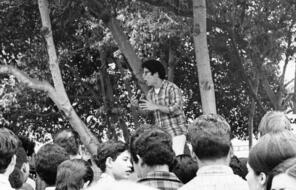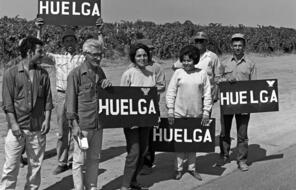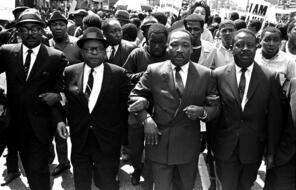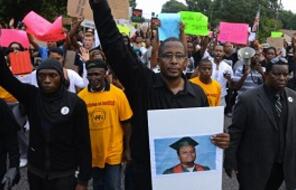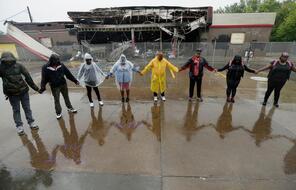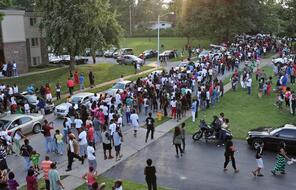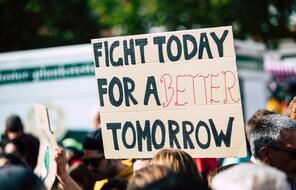Introduction: Growing Resistance Meets Growing Repression
Subject
- History
- Social Studies
Language
English — USUpdated
Steve Biko and SASO | The Durban Strikes of 1973 | The Soweto Student Uprising | “Make apartheid unworkable! Make the country ungovernable.” | The Shifting International Context | Mandela's Leadership From Prison | Negotiations with President Botha | Violence in the Townships | The Negotiated Transition | Violence in the Midst of Negotiations
The 1970s and 1980s saw massive popular unrest break out across South Africa. Among the triggers for the unrest were growing economic inequality, the National Party government’s response to popular protests, outrage over the creation of a tricameral parliament in 1984 that admitted Indian and “coloured” South Africans but not black South Africans, and the fiery message of Steve Biko. The National Party government sought to suppress the majority of the population with aggressive police and military action and government-sponsored death squads that rampaged through the townships. Yet, in contrast to the “successful” crackdown in the 1960s, the government was unable to crush the popular protests that began in the mid-1970s.
Pressure from inside and outside of South Africa ultimately compelled the beleaguered National Party to reform the most objectionable apartheid laws and to come to the negotiating table. Domestic protests and an international anti-apartheid movement eventually pushed the regime to begin negotiations with the head of the African National Congress (ANC), Nelson Mandela, whose imprisonment throughout this period became a symbol for human-rights defenders worldwide. This chapter traces both the process that forced the National Party government of South Africa to reach out to its most hated foes and the ensuing development of cooperation among the sworn enemies.
Steve Biko and SASO
The Rivonia Trial that sent Nelson Mandela and leaders of the African National Congress’s armed wing, uMkhonto we Sizwe, to prison in 1964 did not stem the violence that swept through South Africa’s homelands and white cities in the second half of the twentieth century, but it marked a turning point in how black activists conceived of their mission. While the defendants in the trial reflected the racially inclusive approach of the African National Congress, some black South Africans rejected any plans that did not emerge from a specific experience: that of black South African men and women.
This idea—that a movement not just against apartheid but specifically for black South African liberation was needed—was eventually developed more fully by student leader and activist Steve Biko. In 1968, while he was a student at the University of Fort Hare, Biko led black South African, Indian, and “coloured” students to break with the multiracial National Union of South African Students to form the South African Students’ Organisation (SASO). As president of SASO and through his involvement in other organizations, Biko helped to develop a political philosophy that came to be known as “black consciousness” and that became the basis for the Black Consciousness Movement that ultimately played a key role in undermining the apartheid state.
Steve Biko
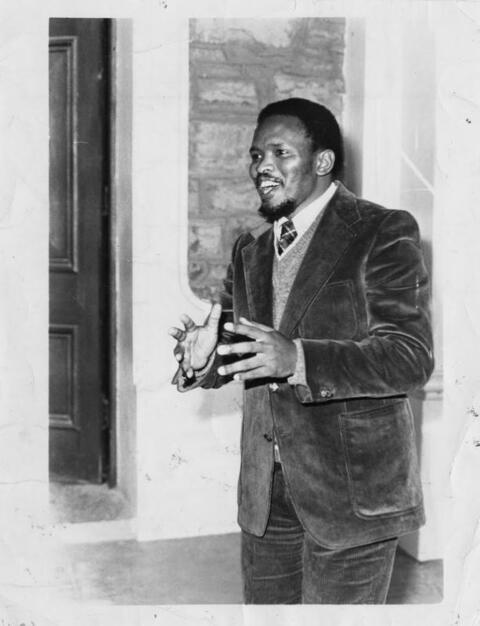
Steve Biko
Steve Biko spearheaded the Black Consciousness Movement (BCM) in South Africa from the mid 1960s until his death while in police custody in 1977.
By drawing on the writings of Frantz Fanon and W. E. B. Du Bois, as well as Eldridge Cleaver and Stokely Carmichael, leaders of the Black Power movement in the United States, Biko concluded that “the black people of the world, in choosing to reject the legacy of colonialism and white domination and to build around themselves their own values, standards and outlook to life,” could work together to overcome the rich nations that had for too long oppressed the “Third World.” 1 Here was an affirmation of black identity and a call for global action in response to a shared experience of oppression. The “policy manifesto” of SASO endorsed “working for the liberation of the Black man first from psychological oppression by themselves through inferiority complex and secondly from physical oppression occurring out of living in a White racist society.” 2 The concept of blackness, as articulated by Biko, included the vast majority of South Africa’s population, seeking to unite peoples who were separated by apartheid’s designations and the history of identity-based separation. This meant calling on people who were identified as—and many who had begun to self-identify as—Indian and “coloured” to claim a shared identity of blackness as an expression of their shared history of oppression. Biko insisted that the only role for white supporters should be in preparing other whites for the coming of black rule. The reading Steve Biko Calls for Black Consciousness includes a fuller expression of his philosophy and aims.
The ideas of black consciousness helped to transform opposition to apartheid, inspiring a new wave of anti-apartheid activism in the 1970s. In his speeches and writing, Biko argued that black South Africans needed to overcome apartheid “of the mind” before they could successfully oppose the discriminatory legal and political system. Education was thus an important focus for activism. Reaching out through schools, SASO advocated a complete break with the so-called Bantu education system, insisting that young black South Africans take pride in their own traditions rather than accept a colonial education system. The separate schools mandated by apartheid functioned to break down resistance to white domination, but that resistance spiked when the government decided to put greater emphasis on teaching the Afrikaans language in schools.
Biko was ultimately persecuted for his activism. In 1972, he was expelled from the University of Natal, and in 1973, the South African government banned him—meaning that he could not speak in public or publish, and quoting his words became illegal. He was also forbidden from traveling outside his home region. Despite these bans, his ideas and the Black Consciousness Movement continued to spread. Biko was arrested in 1977 during a government crackdown. He was tortured while held by the security services and died in custody.
The Durban Strikes of 1973
In the early 1970s, South Africa—thanks in part to a global financial crisis precipitated by a global market downturn in 1973 and 1974—experienced an economic recession that led to massive cutbacks, layoffs, low wages, and rising costs of living. Unemployment increased and living standards dropped. In spite of all the efforts of the National Party, which had long since imposed stringent limits on the rights of workers to unionize and strike, collective action by labor became central to the struggle against apartheid.
- 1Steve Biko, “White Racism and Black Consciousness,” in I Write What I Like: Selected Writings, ed. Aelred Stubbs (Chicago: University of Chicago Press, 1978), 71.
- 2M. Saleem Badat, Black Student Politics, Higher Education and Apartheid, from SASO to SANSCO, 1968–1990 (Pretoria: Human Sciences Research Council, 1999), 377.
The Durban Strikes

The Durban Strikes
The Durban strikes of 1973, and the subsequent formation of new trade unions, were instrumental in causing the first seams of apartheid to break apart.
Starting in the 1950s, National Party leaders sought to dismantle the growing power of the labor movement, and they forced unions to segregate by race. By 1960, most black unions had been banned, though some continued to function underground, and black South African workers could legally strike in only rare circumstances. By the early 1970s, black workers outnumbered white workers four to one. 1 In the manufacturing and construction sector, black workers outnumbered white workers five to one. In 1972 and 1973, what started as a small work stoppage in the port city of Durban, South Africa’s second largest city, cascaded into a series of strikes affecting almost every industry in the city. Despite legal limitations on the organization of unions, on January 9, 1973, brick workers, who faced appalling living and working conditions, walked off the job, demanding raises that would more than double their wages. 2 Although the strikes were illegal, they proved successful at securing many of the workers’ demands. As soon as one strike was resolved—and workers in the manufacturing sector won a raise that varied from 15 to 18 percent—another began, resulting in widespread disruptions. In one of the first strikes, management asked to meet with organizers, but the organizers refused, fearing arrest. Instead, because collective bargaining for black South Africans was illegal, management was forced to meet outdoors with a thousand black workers to try to negotiate wages, new work rules, and a contract.
Between January and March 1973, around 61,000 workers participated in 160 strikes that spilled over into other cities and industrial centers across South Africa. 3 By the end of 1975, two dozen new unions had been established, 4 though only a handful won official recognition. The strikes had an impact on the white South African population that changed the terms and scope of the struggle. White union leaders increasingly came to realize that they needed to support collective bargaining for black workers, worrying that the exploitation of black labor would lead to the suppression of wages for white workers.
The rash of strikes drew a great deal of attention, both at home and overseas. Bowing to this pressure, the national government set up the Wiehahn Commission in 1977 to investigate and recommend a solution to the country’s labor issues. This precipitated the restoration of the right of all workers, regardless of color, race, or sex, to form independent unions, set up standards for fair labor practices, and establish a special industrial court to resolve labor disputes. This was a major victory for all workers, but particularly for black South African workers who had previously been denied the right to form unions. 5
The Durban strikes focused on legal and economic issues, but black workers ultimately realized that merely gaining higher wages would not address the larger problems caused by the apartheid system. Within a few years, they began to include political rights in their demands. One of the workers explained, “I’ve waited nine years for things to improve, but instead things have become worse. We are treated like babies, not like men with brains. Only now that there is trouble they are talking to us like men.” 6
In the heartland of the auto industry, for example, black and coloured South Africans working for Ford and General Motors struck in 1980, not just for better pay but also to force the release from prison of their community leader, Thozamile Botha, a black South African who was also a Ford employee. In 1979, Botha had helped to create one of the first local organizations known as a civic association, which soon became widespread in South Africa. Ford fired the strikers, and in response, black consumers organized a consumer boycott of white-owned businesses.
By 1984, two years after workers formed the National Union of Mineworkers, it reached a membership of some 100,000 workers. 7 Like many smaller unions, it took on a political role, becoming one of the most important players in the campaign against apartheid. With this sort of leverage—the ability to call strikes that paralyzed entire industries—black union leaders and black unions as a whole were a major force compelling prime minister P. W. Botha to repeal the despised pass laws in April 1986.
The Soweto Student Uprising
Residential segregation was a central focus of the apartheid system. As described in Chapter 2, black South Africans were considered citizens not of South Africa but of the various Bantustans, or homelands. Yet the vast majority of black South Africans lived outside these rural areas. Most worked in urban areas and lived in the townships that had been developed by the apartheid government. In the 1950s, the National Party government authorities began to forcibly remove black South Africans from the center cities to townships on the edges of the urban areas. The largest such area into which black South Africans were moved was called the South Western Townships, known more commonly as Soweto.
- 1David Hirschmann, “Pressures on Apartheid,” Foreign Affairs, October 1973, accessed July 31, 2015.
- 2Jerome T. Barrett and Anne Finbarr Mullins, “South African Trade Unions: A Historical Account, 1970–1990,” Monthly Labor Review (October 1990): 25.
- 3Cynthia Malehoko Tshoaedi, “Roots of Women’s Union Activism: South Africa 1973–2003,” PhD dissertation, Leiden University, 2008, 53.
- 4Tshoaedi, “Roots of Women’s Union Activism,” 54.
- 5These results were by no means expected. The commission was created because the white minority “feared that the resurgence of popular-democratic struggle in 1976 would lead to the reestablishment of links between organized labor and popular struggle similar to those in the 1950s and 1960s.” Years later, Nic Wiehahn—head of the Wiehahn Commission—confessed that the impetus to set up the commission and change South Africa’s labor laws had come from industrial leaders who wanted to recover damages from the losses incurred during strikes (Tshoaedi, “Roots of Women’s Union Activism,” 56).
- 6Quoted in “The Role of Organized Labor: The Durban Strikes of 1973,” South Africa: Overcoming Apartheid, Building Democracy website (Michigan State University).
- 7Reader’s Digest Illustrated History of South Africa, 458.
Soweto Youth Uprising
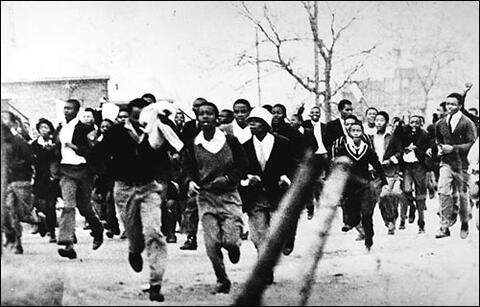
Soweto Youth Uprising
The June 16, 1976, youth-led uprising that began in Soweto and spread countrywide, profoundly changed the socio-political landscape in South Africa.
The policy of eliminating what were called “black spots” by the apartheid government—black enclaves in majority-white areas—by resettling black South Africans in segregated townships was accelerated in the 1960s. As the population rapidly grew, Soweto came to epitomize the challenges faced by those black South Africans who lived in the townships. The government provided very limited resources for infrastructure, healthcare, or education. Black South Africans were not allowed to own property, and laws curtailed local business development. Many of those living in Soweto were there as squatters in shacks built from scrap, and unemployment and crime were rampant. In 1976, only 83% of houses in Soweto had electricity, and 93% had no running water.
Schools in the townships were poorly equipped and underfunded. Many students didn’t have desks, teachers had only cursory training, buildings stood in need of the most basic repairs, books were hard to find, and classrooms grew impossibly crowded. When the government imposed a policy in 1974 requiring that 50% of education be conducted in Afrikaans, a language that black South African students viewed as the language of their oppressors, students protested. Influenced by ideas from the Black Consciousness Movement (BCM) and the South African Students’ Organisation (SASO), many refused to attend classes. Others turned a deaf ear to teachers when they did attend and seldom handed in assignments. At the Phefeni Junior Secondary School, students under the leadership of 15-year-old Seth Mazibuko set up an after-school committee to discuss how to resist Afrikaans as a teaching language while offering their own after-school classes in English.
On June 16, 1976, students backed by SASO and BCM decided to stage a peaceful march that would culminate at Orlando Stadium in Soweto. 1 Some 20,000 black South African students walked out of schools in the Orlando West neighborhood of Soweto, but before they could reach the stadium, police officers set their dogs on them. When students killed a dog in self-defense, police fired on the crowd. The teenagers responded by throwing stones and bottles, in due course “setting fire to symbols of apartheid, such as government buildings, municipal beer halls and liquor stores, buses, and vehicles belonging to white businesses.” 2 The battle between students and police continued into the night, and by the morning of June 17, officials said that 23 protesters were dead; others set the figure as high as 200. Hundreds of people were injured.
What became known as the Soweto student uprising triggered a nationwide schools boycott, and images of the massacre traveled around the world. One particular image, that of 12-year-old Hector Pieterson lying dead in the arms of a fellow student with his 17-year-old sister at his side, came to symbolize the brutality of white supremacy in South Africa. 3
- 1Helena Pohlandt-McCormick, “‘I Saw a Nightmare—’: Doing Violence to Memory,” PhD dissertation, Columbia University, 2000, 1–14, accessed June 14, 2015.
- 2Alistair Boddy-Evans, “16 June 1976 Student Uprising in Soweto,” ThoughtCo.com, accessed July 28, 2015.
- 3Isha Sesay and Mark Tutton, “The Image that Changed the Course of South Africa’s History,” CNN.com, June 16, 2010, accessed July 31, 2015.
The Death of Hector Pieterson
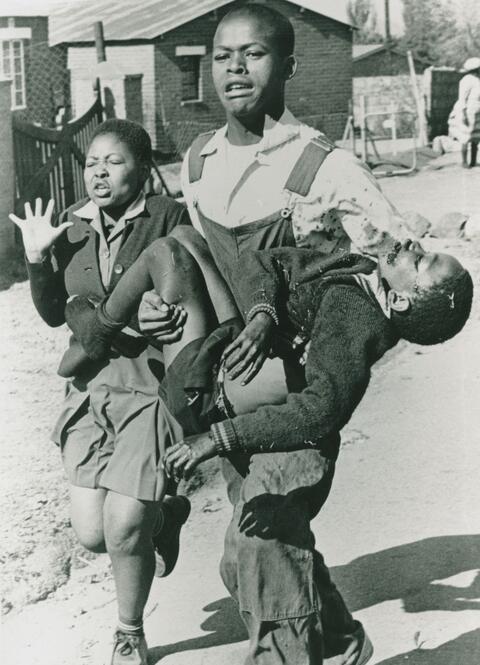
The Death of Hector Pieterson
The iconic photograph of the dead body of Hector Pieterson, age 13, being carried by Mbuyisa Makhuba alongside his sister, received global attention, exposing the world to the horrors of the apartheid government.
“Make apartheid unworkable! Make the country ungovernable.”
As with the Sharpeville massacre in 1960, the Soweto student uprising created a crisis for the apartheid state. In the aftermath of the Soweto uprising, the government arrested thousands of black South Africans, but protests continued to spread. In 1978, P. W. Botha, the minister of defense, became prime minister. Botha militarized the fight against the ANC and other organizations, assigning the South African army the task of policing the townships. He also encouraged the secret police to raid activists’ homes and offices, and they abducted, tortured, and executed political prisoners; in the countryside, more soldiers launched attacks on the training and living areas of anti-apartheid guerrilla fighters, many of whom had been trained in nearby countries harboring large resistance groups. In contrast to the 1960s, however, the government was unable to assert control, as anti-apartheid protests spread and the state’s grip weakened.
In August 1983, a multiracial group of more than 500 churches, civic associations, trade unions, student organizations, and sports teams organized the United Democratic Front (UDF) to coordinate nonviolent opposition to apartheid. 1 The aims of the UDF, led by Anglican archbishop Desmond Tutu, included the abolition of homelands and the creation of a united and democratic South Africa. In 1984, members of the ANC unleashed attacks on government buildings and the homes of government officials, “targets that symbolized Botha’s system of black local government.” 2 Although they disagreed about whether it was acceptable to use violence in the struggle, both the UDF and ANC exhorted their followers, “Make apartheid unworkable! Make the country ungovernable.” 3
The 1980s saw increased resistance—through school and bus boycotts, demonstrations against rent increases, miner strikes, and attacks on infrastructure—in major cities and homelands across the country. The protest posters included in the reading Posters from the Freedom Struggle in the 1980s give a sense of the anti-apartheid movement’s flavor and tone within South Africa during this period. While most protest was peaceful, the challenges to the apartheid state and the government’s response also led to more violent resistance. The apartheid government sought to undermine the anti-apartheid movement in part by encouraging and fomenting violence in black communities. Vigilante mobs, supported by the government, destroyed squatter towns, while in the absence of police protection for black South Africans, local gangs fought for control. In addition, the MK, the military wing of the ANC, began a sabotage campaign against government targets, including an attack on the oil refinery at Sasolburg in 1980. Nearly 100 similar attacks followed. Often coordinated with ANC political rallies and demonstrations, they aimed at sending a message loud and clear: the government was to dismantle apartheid, or no one would be safe.
The Shifting International Context
One major difference between the period after the Sharpeville massacre and the period after the Soweto uprising was a changed international context. In 1960, influential international actors such as the United States and the United Kingdom showed little interest in the plight of South Africa’s black population.The United Kingdom and Portugal retained colonial control over all of the countries neighboring South Africa, and several of these colonies had systems of racial hierarchy and oppression similar to South Africa’s. In the United States, the civil rights movement still faced considerable opposition, and Jim Crow segregation remained widespread. The South African government worked hard to maintain international support, including the support of these influential states, by actively justifying apartheid policies as necessary for South Africa. The reading Selling Progress: A South African Filmstrip for American Students illustrates some of these propaganda efforts.
By 1976, all of South Africa’s neighbors except Rhodesia (known as Zimbabwe today) had gained independence, with black-majority governments. A number of these governments actively opposed apartheid. They came to be known as the Frontline States, and several of them allowed the ANC to operate on their territory.
Most governments in Europe and North America continued to take a cautious approach to addressing apartheid, in part because they saw the white South African government as an ally in the fight against the spread of communism. From the late 1970s, the apartheid government began to justify the continuation of apartheid and its repressive policies as a bulwark against the spread of communism. The National Party did this both within and outside of South Africa, painting anti-apartheid activists as communists. They constructed a moral view of apartheid, one which appealed to the US and other countries that were fighting the Cold War. But emerging popular opinion was turning against apartheid. Major social movements in the 1960s and 1970s had challenged racial and other forms of inequality and transformed societies in the United States, the UK, France, and elsewhere. To many of the people involved in those movements, South Africa’s apartheid system was an offensive holdover from an earlier era of colonialism and racist oppression, and they pushed their own governments to take a stronger stand against apartheid.
In addition to pressuring governments to change their policies, anti-apartheid activists looked for other ways to pressure South Africa to end apartheid and move toward democratic majority rule. International sporting organizations such as the Olympics and the FIFA soccer federation began excluding South African teams from international competition in the 1960s and 1970s. The role of international corporations in supporting the apartheid system became another major focus of activists. In the early 1970s, workers at Polaroid in the United States became aware of the use of their company’s cameras and film in making the passbooks that all black South Africans were required to carry. These workers asked that Polaroid withdraw from South Africa and then organized a consumer boycott that ultimately led the company to pull out of the country in 1977. The reading What Is Ethical?: The Case of Polaroid details the debate surrounding this episode and the considerations confronted by those involved.
The gruesome images from the Soweto student uprising that circulated internationally and the success of the Polaroid boycott inspired activists to put pressure on many other corporations to withdraw from South Africa, and companies that refused to do so began to face consumer boycotts. Activists also encouraged investors to pressure their corporations to pull out of South Africa. In the 1980s, a largely student-led movement spread on campuses across the US demanding that colleges and universities withdraw their investments (a practice known as divestment) from corporations doing business in South Africa.
The idea of targeting South Africa’s business sector was intended to isolate the country economically. Defenders of the apartheid system claimed that the boycotts and divestment would hurt the black population disproportionately. But the boycotts were coordinated with anti-apartheid activists in South Africa, who insisted that the black population was already suffering and that the white government would listen if apartheid began to affect their bottom line.
International support proved crucial to the efforts to force South Africa’s white-dominated government to ultimately accept political reform. The Frontline States enforced a boycott on South Africa, limiting the market for South African goods that, coupled with consumer boycotts elsewhere and divestment by corporations, began to hurt South Africa’s economy. Sports boycotts and international condemnation created an increasing sense of isolation on the part of the white minority government and its white citizens. At the same time, the international anti-apartheid movement provided moral support that helped to reduce the sense of isolation for the domestic anti-apartheid movement.
- 1“United Democratic Front (UDF),” South African History Online website, accessed June 15, 2015.
- 2Nancy L. Clark and William H. Worger, South Africa: The Rise and Fall of Apartheid, 2nd ed. (Harlow: Longman, 2011), 98.
- 3Clark and Worger, South Africa, 98.
Southern Africa Frontline States
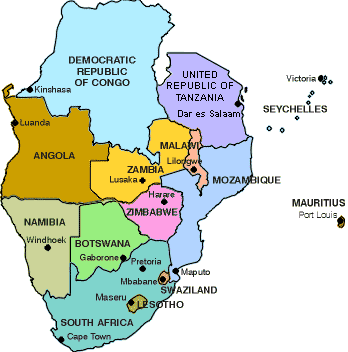
Southern Africa Frontline States
The collapse of apartheid and the implementation of a democratic government in South Africa was regionally supported by a group of southern African states called the Frontline States. (The Democratic Republic of Congo, pictured here, was not supportive of the liberation.)
Mandela’s Leadership from Prison
The combined pressures of domestic and international opposition ultimately pushed the apartheid government to negotiate a political transition. The National Party government increasingly recognized that its position was precarious and untenable and began the process of early interactions with Nelson Mandela, whom its leaders saw as the representative of anti-apartheid resistance. These were early, tentative steps.
Nelson Mandela had arrived at the Robben Island prison, four miles off the shore of Cape Town, in the winter of 1964; he would not leave for 18 years. His cell throughout much of that time was barely large enough for any human, let alone one who was six feet tall, and it consisted of little more than a floor mat for a bed and a bucket for a toilet. He was permitted to write and receive one letter every six months and was allowed one visitor per year—the visit to last no more than 30 minutes. 1 Yet, despite his inability to communicate directly, he was viewed both inside and outside the prison gates as the symbolic leader of the liberation movement.
While in prison, Mandela focused both on improving the treatment of prisoners and on furthering the campaign against apartheid. Soon after his arrival, Mandela and other black prisoners turned to acts of disobedience, such as hunger strikes. As fellow prisoner Neville Alexander recalled, “[Mandela] always made the point, if they say you must run, insist on walking. If they say you must walk fast, insist on walking slowly. That was the whole point. We are going to set the terms.” At the same time, Mandela sought informal interactions with the guards to “persuade them to treat him with dignity.” 2 In order to know his enemy, Mandela applied himself rigorously to the study of Afrikaans and Afrikaner history; guards and wardens came to admire his knowledge of their culture. Once, during a visit from his lawyer, Mandela introduced the guards accompanying him as his “guards of honor,” disarming his keepers. 3
Throughout the period of Mandela’s incarceration, the armed wing of the ANC, Umkhonto we Sizwe (MK), was effectively at war with the state. A guerrilla himself, Mandela endorsed this strategy while insisting on the value of peaceful negotiations. As he explained at his 1964 trial:
I, and some colleagues, came to the conclusion that as violence in this country was inevitable, it would be unrealistic and wrong for African leaders to continue preaching peace and non-violence at a time when the Government met our peaceful demands with force. . . . It was only when all else had failed, when all channels of peaceful protest had been barred to us, that the decision was made to embark on violent forms of political struggle . . . 4
Yet Mandela’s attitude toward his jailers revealed a man determined to see the humanity in his foes. He recognized the need to compromise and to adopt new methods when the old ones ceased to produce results.
Negotiations with President Botha
The National Party cultivated the idea that Mandela and other anti-apartheid activists were terrorists. This was a view that many white South Africans and people outside South Africa shared. But by the 1980s, the campaign to free Mandela had gained widespread international attention, and stories of his continued imprisonment had become an entry point for the growing international anti-apartheid movement. For example, a multiracial ska band from the United Kingdom, The Special AKA, scored a top-ten hit in 1984 with the song “Free Nelson Mandela.” Black South African musician Hugh Masekela had a hit in 1987 with “Bring Him Back Home (Nelson Mandela),” which included these lyrics:
Bring back Nelson Mandela
Bring him back home to Soweto
I want to see him walking down the street
With Winnie Mandela
In the Netherlands, there was an active anti-apartheid campaign that began in the wake of the Soweto uprising and was led by Dutch students. Their “Free Nelson Mandela” campaign targeted individuals and local groups with the goal of influencing politicians across parties. They also sought to strategically engage with Oliver Tambo, then living in exile, who was traveling to the Hague as part of his work for the ANC outside of South Africa. 5
As part of his strategy of stopping protests by granting concessions, President Botha made a public show in 1985 of offering to free Nelson Mandela if Mandela both gave up politics forever and renounced the violent tactics used by the unofficial military wing of the African National Congress. 6 Mandela refused Botha’s offer. The reading Mandela’s Strategic Decision includes the text of his detailed response, read by his daughter before tens of thousands of people gathered in Soweto.
Later in 1985, secret negotiations began between Mandela and members of Botha’s administration. The first meeting took place in November 1985, while Mandela was recovering from surgery, with the minister of justice and prisons. When Mandela was returned to incarceration, he was given a cell where he could speak privately with government officials. For the first time, members of South Africa’s white government showed a willingness to discuss the future of the nation with a black politician intent on ending apartheid.
Mandela began to work through the chain of command to gain a meeting with President Botha himself. Before Botha would agree to meet, he sought assurances from Mandela that if black South Africans gained power, they would not take vengeance on white South Africans. From July 1986 through the end of 1987, Mandela and various government officials debated the terms under which the National Party government would be willing to relinquish power. Compromise became a central theme in the transition to democracy. Mandela never demanded or expected a complete capitulation by the National Party government, because he believed that this would have unleashed a backlash by white South Africans. Mandela believed—and convinced his leadership team once he let them know about his ongoing negotiations—that the National Party government would cede power only if white South Africans retained their economic assets. This would prove to be one of the most galling concessions for the black South African men and women whose labor had been exploited for centuries.
On July 5, 1989, Botha and Mandela met at Tuynhuys, the official workplace of South Africa’s head of state. For Mandela, this day marked “a point of no return”—the day he knew for certain that apartheid would soon end. 7 The meeting was top secret; not even Botha’s own security detail knew it was taking place. Mandela, being a shrewd politician who knew a great deal about his country’s history and mores, deliberately chose to speak Afrikaans and drew comparisons between Afrikaner and black South African history. This made Botha especially receptive to him and his demands. When Mandela brought up the release of political prisoners, Botha agreed. 8 Much remained to be done, but from that moment there was no going back.
Violence in the Townships
A pressure point for Botha and the National Party—as well as Mandela and the other resistance leaders—was the spread of protests and violence within the country. By the end of the 1980s, violence in the townships had climbed to unprecedented levels. No group or organization, including the ANC and the UDF, could contain the anger of a new generation of black youth frustrated by the deplorable and inhumane conditions they faced, including dire poverty, poorly funded schools whose few teachers were utterly demoralized, and a bleak job market. Desperate and with nothing to lose, they took over the streets. They enforced school boycotts, turned out for marches, and enthusiastically confronted the security forces. These youth, known as the “Young Lions,” represented a desperate generation: they were willing to die for freedom and were finished with compromise. Politically motivated protest mixed with simple criminality in ways that made them difficult to distinguish. The protests and violence made South Africa increasingly ungovernable and and contributed to bringing leaders from both sides to the bargaining table. The secret negotiations for political transition began in this context of unrest.
Yet even as President Botha was engaged in negotiations for a transfer of power, his government continued to seek to gain the upper hand over the black South African majority, in part by exploiting the growing frustration and violence in the townships. In response to the mounting unrest in the country, President Botha declared a state of emergency for all of South Africa in 1986. He called thousands of white army reservists to active duty, gave law-enforcement agencies a free hand to issue arbitrary orders, and authorized the arrest of hundreds of activists and ANC supporters. Citing the increasing violence, he argued that the situation made it impossible for “the reasonable majority to continue the search for a peaceful and democratic solution.” 9
One strategy that the apartheid government used to try to undermine the anti-apartheid movement was to encourage violence within black communities. The government created a secretive “third force” composed of security police, former criminals and other black Africans, that targeted anti-apartheid activists and created general disruption in black communities. Although many black South Africans suspected that the third force was coordinated, equipped, and funded by law enforcement agencies, it was not until after the transition to democratic rule that proof was found that these forces were in fact paid to torture and kill the government’s perceived political enemies. At the time, the government claimed that these killing squads did not exist; they blamed “dissident” groups of the ANC for attacks on anti-apartheid activists. They also spread the language of “black on black” violence. In 1986, Crossroads, a vast squatter camp just outside Cape Town with a population of over 110,000, became the target of an armed black group supported by the security services that was opposed to the anti-apartheid movement. In May and June, a vigilante mob entered the camp and, in a bout of unimaginable violence, set hundreds of buildings ablaze, terrorized the population, and forced 60,000 people from their homes. The mob, far more organized than it appeared, had been assisted by the South African government.
We now know that much of the violence that shook the country between the mid-1980s and the climactic 1994 election was sponsored and often organized by a secret-police unit led by Eugene de Kock. The purpose of these attacks was clear: to prevent the ANC from consolidating its power among black and coloured constituencies, reducing its leverage in the negotiations to end apartheid.
The Negotiated Transition
When President Botha resigned in August 1989, following a mild stroke, Frederik Willem de Klerk succeeded him as president, and he took over the process of negotiating a political transition. A conservative champion of Afrikaner nationalism, de Klerk was not the likeliest person to end apartheid. While he had been involved, as a government minister, in the repeal of laws banning interracial sex and marriage, he remained a proponent of white political rule. But it was the intensification of resistance, both within and outside of the country, the near bankruptcy of the economy, and the changing international environment as the Cold War came to an end that brought de Klerk to lead the government down a new path. Shortly after becoming president, in October 1989, he ordered the release of many prisoners, including several from the Rivonia Trial.
On December 13, 1989, Mandela presented to de Klerk the conditions under which negotiations for a transfer of power could begin, including the release of all political prisoners, lifting of bans on black political and labor organizations, and the withdrawal of troops from the townships. After their meeting, Mandela recalled:
Mr. de Klerk listened to what I had to say. This was a novel experience. National Party leaders generally heard what they wanted to hear in discussions with black leaders, but Mr. de Klerk seemed to be making an attempt to truly understand. . . . “You know,” he said, “my aim is no different than yours. Your memo to P. W. Botha said the ANC and the government should work together to deal with white fears of black domination, and the idea of ‘group rights’ [that no racial or ethnic group could take precedence over any other] is how we propose to deal with it.” I was impressed with this response, but said that the idea of “group rights” did more to increase black fears than allay white ones. De Klerk then said, “We will have to change it, then.” 10
Nelson Mandela was released from prison on February 11, 1990. At the same time, the government lifted official bans against the ANC, the PAC, the South African Communist Party, and other anti-apartheid groups. Returning to his post as leader of the ANC, Mandela took the lead in formal negotiations with the National Party government over a peaceful transition of power to democratic majority rule. Although both the National Party government and anti-apartheid groups such as the MK had employed violence in the struggle for and against apartheid, the transition was accomplished in the end through negotiation, not through the military victory of one side or the other.
Both sides had to compromise. A key strategy during the negotiations was an effort to build relationships across and among party leaders. ANC chief negotiator Cyril Ramaphosa and the chief negotiator for the National Party, Roelf Meyer, recognized that their ability to work well together in the interests of South Africa as a whole was paramount for the success of negotiations. The National Party and the ANC both had bargaining power, but both also had to make concessions. While the ungovernability was a crucial factor in bringing the National Party to the table, the white-controlled government retained substantial power, including military and police forces. The resulting plan for South Africa’s post-apartheid political, social, and economic systems reflected these factors. Indeed, the compromises from these negotiations continue to shape present-day South Africa.
Many of the agreements negotiated between the National Party government and the ANC were set down in an interim constitution adopted in 1993 that took effect on election day in 1994. The interim constitution guaranteed extensive protection of human rights, declaring equality before the law and a guarantee of the right to life and the right to human dignity. It established 11 official national languages, including English, Afrikaans, and the nine main African languages.
The National Party was particularly concerned that whites might be entirely shut out of government, so they insisted on a political system in which minority groups were guaranteed access to power. Although the ANC refused to allow provisions that would give the white minority an effective veto over legislation, the constitution did include many provisions that would allow the white minority to continue to have an influential voice in government. The National Assembly was to be elected through a proportional system with no minimum electoral threshold, meaning that even parties with less than 1% of the vote could gain representation in the parliament. Any party that received at least 5% of the seats in the National Assembly was guaranteed a seat in the national unity government cabinet that would be set up after the elections. Any party that won at least 20% of seats in the National Assembly was also guaranteed a vice presidential position.
The constitution also created nine provinces, with provincial legislatures and governments. This allowed groups that might not be able to gain a majority at the national level to potentially win elections at the regional level where their population was more concentrated, like the Zulu in KwaZulu-Natal or the whites and coloureds in the Western Cape. 11 Critically, the interim constitution also established South Africa’s Constitutional Court, perhaps the central institution for supporting the country’s democracy. The Constitutional Court is South Africa’s highest court and was created with the recognition that the existing judicial system, which was largely white and male, could not legitimately represent all South Africans or the new constitutional structure. The idea for the court had roots in the early ANC and the Freedom Charter.
The central compromise that made the white government willing to accept a transition was the agreement by the ANC to focus on gaining political power for the black majority while protecting white economic power. In exchange for an open democratic voting system, the ANC agreed that the government would not seize white-owned farms or businesses and turn them over to black South Africans. Instead, they said that they would invest in improving the infrastructure for the black population and seek to concentrate the benefits of new economic growth in black communities. Over the objections of many anti-apartheid activists, who argued that whites had unjustly seized black land without compensation, the interim constitution included a guarantee of property rights. As a result, the transition did not fundamentally alter South Africa’s economic system, and economic inequality became a major challenge for post-apartheid governments to confront.
Although the ANC disagreed with the National Party on a number of specifics, its leadership remained committed to the principle of nonracialism first articulated in the Freedom Charter back in 1955. Chris Hani, a leader in both the ANC and the South African Communist Party, expressed a sentiment supported by many other ANC activists when he said, “I will not be part of blacks oppressing whites, that is not the path of reconciliation.” He went on to argue that black South Africans did not need to oppress whites in order to improve their lives. “With mineral resources, universities and a beautiful land, if utilised properly, South Africa has tremendous potential to have a prosperous economy.” 12 Sadly, Hani, whom many saw as Nelson Mandela’s natural successor as head of the ANC, was assassinated in April 1993 by a Polish immigrant who was encouraged to commit the killing by a leader of an ultra-nationalist white party opposed to the transition to majority rule.
With the interim constitution adopted on December 18, 1993, the country moved toward national and provincial elections that would mark the formal transition to democratic majority rule.
Violence in the Midst of Negotiations
One of the popular myths about South Africa’s transition is that it was bloodless. While South Africa did not devolve into civil war, the transition was violent and bloody. More lives were lost during the period of transition than throughout the entire period of apartheid. Even as the government led by President de Klerk was engaged in negotiations with the ANC and other parties on the terms of a political transition, it continued to seek to undermine its opponents by fostering divisions and increasing popular insecurity. Largely as a result of the “third force” that targeted many people involved in the anti-apartheid movement and sought to sow general discord in black communities, South Africa’s townships experienced tremendous violence between 1990 and 1994.
For their part, supporters of the anti-apartheid movement retaliated against people they suspected of being government agents. “Necklacing,” a type of lynching in which a rubber tire is placed around a target and set on fire, burning the victim to death, became a common practice used to punish supposed sellouts and to discourage other black South Africans from working with the government. As a result of both the “third force” and reactions from anti-apartheid activists, dead bodies appeared daily on remote dirt roads, in ditches along the highways, and in the townships themselves. Government officials estimate that as many as 14,000 people, mostly black, were killed during this period; many were activists and their families. 13
Some of the violence in the early 1990s erupted from political rivalries. The Inkatha Freedom Party (IFP) was involved in many killings of ANC members; members of the ANC are known to have committed similar acts but on a smaller scale. The IFP was a group that promoted the interests of the Zulu people and worried that the end of apartheid would diminish the power of the Zulu chiefs. In its campaign against the ANC’s plans for a united South Africa, the IFP militia received weapons and training from the South African special forces. It also collaborated with the government in a campaign designed to break the backbone of the opposition to apartheid (Operation Marion). In the early 1990s, with continued support from the government, the IFP carried out hundreds of killings of ANC supporters and came close to sparking civil war.
The white-dominated National Party government cynically hoped that the violence in the townships would sow doubts among white South Africans about rule by black South Africans and undermine support for the ANC. As the date for South Africa’s first free elections approached in April 1994, there was considerable anxiety about whether they would take place peacefully. In the end, while the elections occurred largely without incident, the legacies of violence in South African society have endured.
- 1“The Long Walk of Nelson Mandela: The Prisoner,” FRONTLINE (PBS), March 1, 2012, accessed July 28, 2015.
- 2John Carlin, Playing the Enemy: Nelson Mandela and the Game that Made a Nation (New York: Penguin, 2008), 28.
- 3Carlin, Playing the Enemy, 27, 29.
- 4Nelson Mandela, “Nelson Mandela’s statement from the dock at the opening of the defence case in the Rivonia Trial,” April 20, 1964, African National Congress website, accessed December 19, 2012.
- 5See “Report on Campaign ‘Nelson Mandela Free’ In the Netherlands” and “The Neterlands and Nelson Mandela,” International Institute of Social History (PDF resources).
- 6Richard Stengel, “Mandela: His 8 Lessons of Leadership,” Time, July 9, 2008, accessed July 28, 2015.
- 7Patti Waldmeir, Anatomy of a Miracle: The End of Apartheid and the Birth of the New South Africa (New Jersey: Rutgers University Press, 1998), 106.
- 8“Mandela and Botha: The Crocodile and the Saint,” The Independent, November 2, 2006, accessed July 28, 2015.
- 9Michael Parks, “S. Africa Declares Emergency Rule; 1,200 Rounded Up: Botha Gives Nearly Unlimited Power to Police to Deal With Growing Strife,” Los Angeles Times, June 13, 1986.
- 10Nelson Mandela, Long Walk to Freedom: The Autobiography of Nelson Mandela (Boston: Little, Brown and Company, 1994), 555.
- 11Republic of South Africa, “Constitution of the Republic of South Africa, 1993,” South African Government website.
- 12Rea Khoabane, “Chris Hani’s Last Words,” Rand Daily Mail, September 14, 2014.
- 13“TRC Final Report,” SABC website, accessed June 15, 2015.
How to Cite This Reading
Facing History & Ourselves, “Introduction: Growing Resistance Meets Growing Repression”, last updated August 3, 2018.

